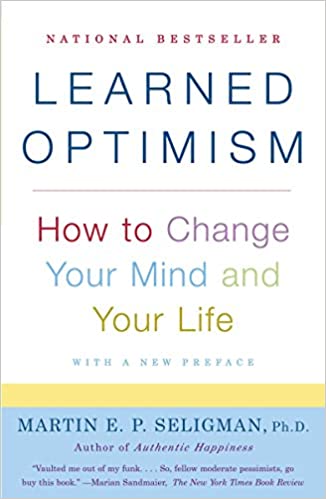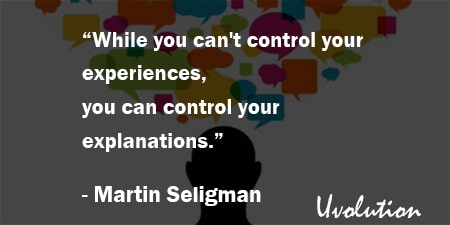Learned Optimism by Martin Seligman
The Book in 1 Sentences
Learned Optimism: How to Change Your Mind and Your Life
“Habits of thinking need not be forever. One of the most significant findings in psychology in the last twenty years is that individuals can choose the way they think.” ~ Martin Seligman
5 BIG Ideas
1. An optimistic explanatory style stops helplessness, whereas a pessimistic explanatory style spreads helplessness.
2. Cognitive therapy works because it changes explanatory style from pessimistic to optimistic.
3. Success requires persistence, the ability to not give up in the face of failure.
4. Unlike dieting, learned optimism is easy to maintain once you start.
5. “The life committed to nothing larger than itself is a meager life indeed. Human beings require a context of meaning and of hope.”
Learned Optimism Book Summary
1. Optimism Vs Positive Thinking
“Learned optimism is not a rediscovery of the ‘power of positive thinking.’ … Changing the destructive things you say to yourself when you experience the setbacks that life deals all of us is the central skill of optimism.”
“Pessimists can in fact learn to be optimists, and not through the mindless devices like whistling a happy tune of mouthing platitudes (‘Every day, in every way, I’m getting better and better’), but by learning a new set of cognitive skills.”
2. Learned Helplessness
“Learned helplessness is the giving up reaction, the quitting response that follows from the belief that whatever you do doesn’t matter.
Explanatory style is the manner in which you habitually explain to yourself why events happen. It is the great modulator of learned helplessness.
An optimistic explanatory style stops helplessness, whereas a pessimistic explanatory style spreads helplessness.”
Learned helplessness theory was developed by Seligman and his colleagues in their work with dogs.
Imagine two dogs: The first dog is slightly shocked but has a lever he can push that will stop the shocks. He quickly learns to stop the shocks.
A second dog does not have a lever. He can’t stop the shocks. So, he LEARNS that he is helpless in the face of these shocks.
Then, the dogs are moved to a new area and taught a new way to avoid the shocks. So, now both of them can avoid the shocks. Remarkably, although the first dog avoids the shocks, the second dog curls up in the corner and whimpers as the shock—which he could have avoided—is administered. He’s learned helplessness.
This theory also applies to humans… we LEARN helplessness when we believe that if we fail once we’ll keep failing in everything! And then give up… And that of course leads to depression.
So, to solve this problem, the key is our explanatory styles.
3. Explanatory Styles
“On a mechanical level, cognitive therapy works because it changes explanatory style from pessimistic to optimistic, and the change is permanent. It gives you a set of cognitive skills for talking to yourself when you fail.”
It’s all about our self-talk (or internal dialogue).
Think about your self-talk when something bad happens to you… Is it something like “It’s my fault” “I’ll never make it” or “It’s OK!” “I’ll try to fix this” …etc.
Seligman calls the way we interpret events our explanatory style.
He has identified three primary elements of our explanatory style: permanence, pervasiveness, and personalization. Your current tendencies dictate your level of optimism.
Explanatory Style 3 P
“There are three crucial dimensions to your explanatory style: permanence, pervasiveness, and personalization.”
Permanence: Is it permanent or temporary?
Think about when something happens. Do you think the result of it is permanent or temporary?!
In case of a bad event, the optimist tends to think it’s a temporary thing. If it’s a good thing, they tend to think it’s permanent.
While the pessimist thinks that good things are temporary and bad things are permanent.
Pervasiveness: Is it reflective of your whole life? Is it “universal” or is it “specific”?
So, do we think the results of this one event apply to everything in our lives, or just that situation?
With a good event, the optimist is more likely to extend it to his/her whole life. With a bad event, he/she will tend to isolate the incident as specific to that situation.
While the pessimist. If something good happens, they think it was a one-time success. If something bad happens, they think it is representative of their whole life.
Personalization: Internal or external?
Do we believe that we are responsible for the event, or if something outside of our control was responsible?
In case of a good thing:
An optimist says: I did it saying (internal)
A pessimist is more likely to attribute the success to luck, other people’s hard work, or something else (external).
In case of a bad thing:
The optimist looks to things outside of himself (external)
The pessimist always takes responsibility for the bad event (internal).
Seligman addresses the fact that optimism is not always a good thing. Although you to have hope and optimism for a bright future, you also need a healthy dose of realism to ensure success.
4. Ingredients of Success
“holds that there are two ingredients of success… the first is ability or aptitude, and IQ tests and SAT are supposed to measure it.
The second is desire or motivation. No matter how much aptitude you have, says traditional wisdom, if you lack desire you will fail. Enough desire can make up for meager talent.”
Seligman continues: “I believe that traditional wisdom is incomplete. A composer can have all the talent of Mozart and a passionate desire to succeed, but if he believes he cannot compose music, he will come to nothing. He will not try hard enough. He will give up too soon when the elusive right melody takes too long to materialize.
Success requires persistence, the ability to not give up in the face of failure. I believe that optimistic explanatory style is the key to persistence.”
“The explanatory-style theory of success says that in order to choose people for success in a challenging job, you need to select for three characteristics:
1. aptitude
2. motivation
3. optimism”
“Optimism tells you who to select and recruit. If two prospects are close in raw talent, recruit the optimist. He’ll do better in the long run.”
5. Be Optimistic!
“Life inflicts the same setbacks and tragedies on the optimist as on the pessimist, but the optimist weathers them better.”
Optimism affects performance professionally and personally and it also plays a significant role on our overall health—from different rates of cancer to overall immune functioning.
“Unlike dieting, learned optimism is easy to maintain once you start. Once you get into the habit of disputing negative beliefs, your daily life will run much better, and you will feel much happier.”
6. Meaning and Hope
“The life committed to nothing larger than itself is a meager life indeed. Human beings require a context of meaning and of hope.”
That was my QUICK Learned Optimism summary. If you’re interested, get your copy. There is a HUGE amount of wisdom and life-changing ideas in this book, and we’ve only touched on a tiny bit of it.
Buy The Book: Learned Optimism by Martin Seligman

GET Blinkist 7 Days FREE Trial
3000+ Book Summaries
(Audio and Text)





